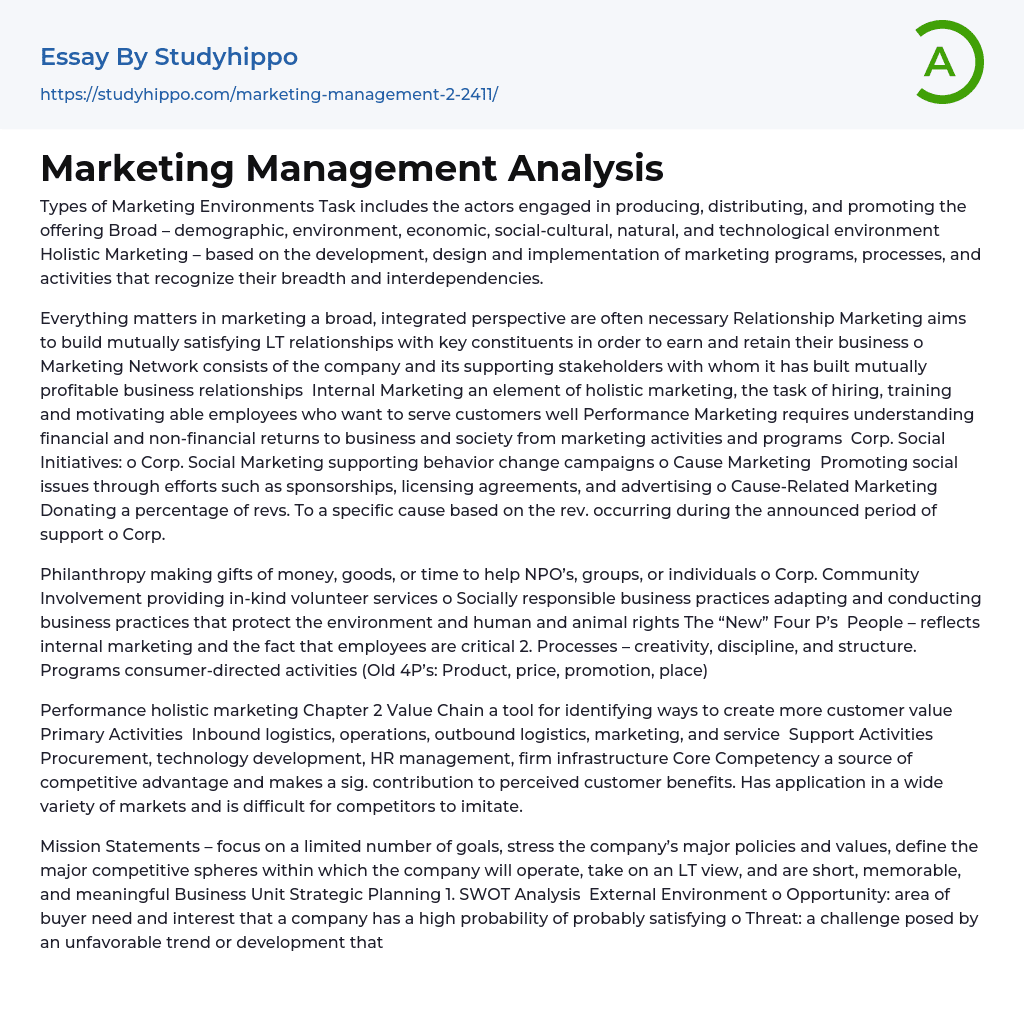The text discusses various types of marketing environments and strategies. These include broad demographic, environmental, economic, social-cultural, natural, and technological environments. Holistic marketing recognizes the interdependencies between various marketing programs, processes, and activities. Relationship marketing focuses on building long-term relationships with key constituents to earn and retain their business. Marketing networks involve mutually profitable relationships between the company and its supporting stakeholders. Internal marketing involves hiring, training, and motivating employees who are committed to serving customers well. Performance marketing involves understanding the financial and non-financial returns from marketing activities. Corporate social initiatives include corporate social marketing, cause marketing, and cause-related marketing, which involve supporting behavior change campaigns and promoting social issues through sponsorships, licensing agreements, and advertising. Additionally, cause-related marketing involves donating a
... percentage of revenue to a specific cause based on the revenue generated.
During the announced period of support, Corp. Philanthropy engages in giving gifts of money, goods, or time to help NPO’s, groups, or individuals. They also engage in Corp. Community Involvement by providing in-kind volunteer services. In addition, they adapt and conduct socially responsible business practices that protect the environment and human and animal rights.
The "New" Four P's include People, which reflects internal marketing and recognizes the criticality of employees. Processes involve creativity, discipline, and structure. Programs are consumer-directed activities. This is an update from the old Four P's: Product, price, promotion, place.
Chapter 2 introduces the concept of the Value Chain as a tool for identifying ways to create more customer value. The Value Chain consists of primary activities such as inbound logistics, operations, outbound logistics, marketing, and service, as well as support activities such as procurement, technology development, HR management, and
firm infrastructure.
Lastly, Core Competency is defined as a source of competitive advantage that makes a significant contribution to perceived customer benefits.
The text emphasizes that the application of this concept extends to various markets and is challenging for competitors to replicate. Mission Statements, on the other hand, focus on a limited number of goals, highlight the company's major policies and values, define the primary competitive areas of operation, and take a long-term perspective. Additionally, they are concise, memorable, and meaningful. Business Unit Strategic Planning involves conducting a SWOT Analysis to assess external opportunities and threats. Opportunities are defined as areas where the company is likely to meet buyer needs and interests successfully, while threats refer to unfavorable trends or developments that could lead to decreased sales or profit without defensive marketing action. Strengths and weaknesses are evaluated in the internal environment. Goal formulation and strategic formulations follow thereafter.
Porter’s Generic Strategies include overall cost leadership, differentiation, and focus on one or more narrow market segments, with the option to pursue cost leadership or differentiation.
The forms of strategic alliance are:
- Product or service
- Promotional alliance (e.g. Disney toy Happy Meal)
- Logistics alliance
- Pricing collaborations (e.g. hotel and car rental companies)
- Program Formulation and implementation
- Feedback and Control Marketing Plan Sections
The marketing plan consists of the following sections:
- Executive Summary and TOC
- Situation Analysis – presents relevant background data on sales, costs, the market, competitors, and various forces in the macro-environment
The marketing manager is responsible for defining the mission, marketing, and financial objectives, as well as determining the market offering needed to meet these objectives and achieve competitive positioning.
Financial projections, including a sales forecast, expense forecast, and break-even analysis, are included. Implementation Controls are outlined to monitor and adjust the plan's implementation. This information can be found in Chapter 3.
- Chief Executive Officer essays
- Convenience Store essays
- Firm essays
- Training And Development essays
- Unilever essays
- Variable Cost essays
- Virgin Group essays
- Bargaining essays
- Entity essays
- Pest analysis essays
- John Locke essays
- 9/11 essays
- A Good Teacher essays
- A Healthy Diet essays
- A Modest Proposal essays
- A&P essays
- Academic Achievement essays
- Achievement essays
- Achieving goals essays
- Admission essays
- Advantages And Disadvantages Of Internet essays
- Alcoholic drinks essays
- Ammonia essays
- Analytical essays
- Ancient Olympic Games essays
- APA essays
- Arabian Peninsula essays
- Argument essays
- Argumentative essays
- Art essays
- Atlantic Ocean essays
- Auto-ethnography essays
- Autobiography essays
- Ballad essays
- Batman essays
- Binge Eating essays
- Black Power Movement essays
- Blogger essays
- Body Mass Index essays
- Book I Want a Wife essays
- Boycott essays
- Breastfeeding essays
- Bulimia Nervosa essays
- Business essays
- Business Process essays
- Canterbury essays
- Carbonate essays
- Catalina de Erauso essays
- Cause and Effect essays
- Cesar Chavez essays




